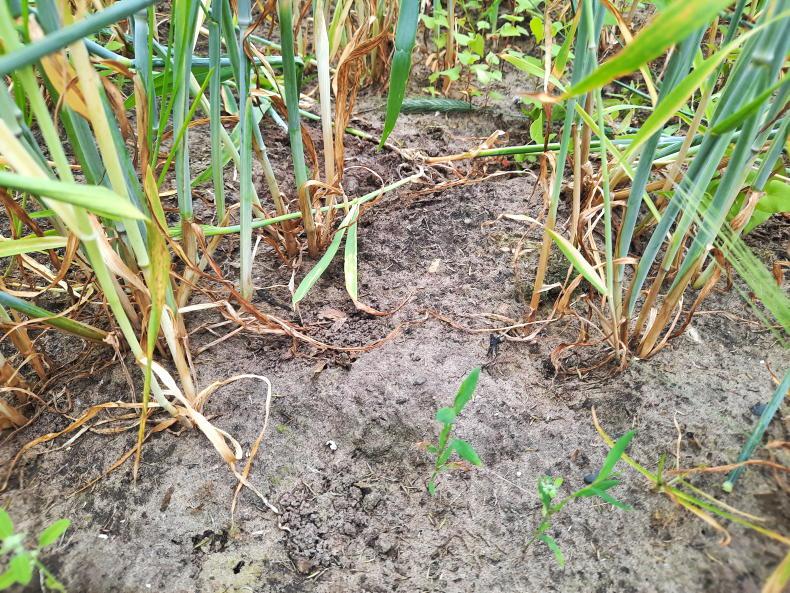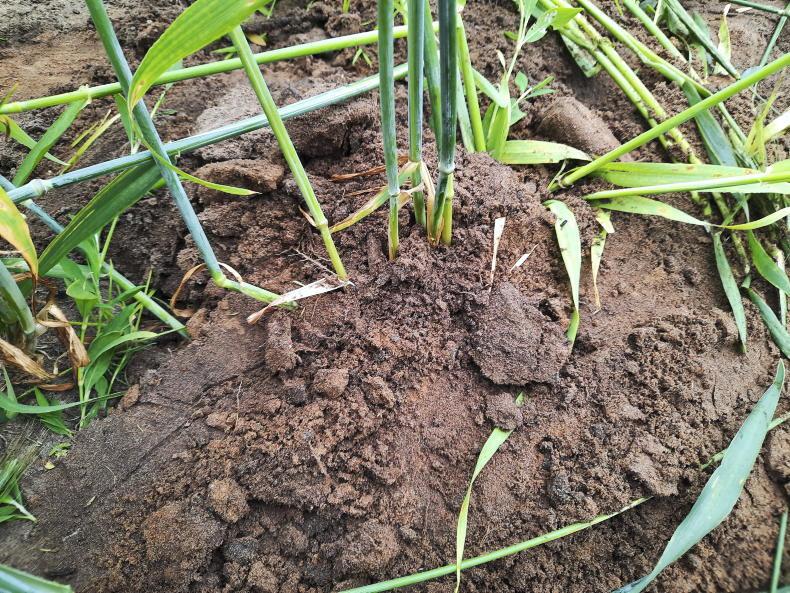Jonathan Kelly was a new entrant into tillage farming a few years ago. He was largely a beef farmer and is now mainly tillage with some beef. The Irish Farmers Journal visited Jonathan’s farm on the Irish Tillage and Land Use and Ulster Arable Society’s Summer Field Tour.
The young Derry man farms under Binevenagh Mountain on land reclaimed from the sea and when we visited we saw crops growing on sand. It was like walking along a beach and Jonathan said that if you look through the soil you will see sea shells, but the crop of rye was so heavy it was hard to spot them in the middle of June.
Jonathan said that at times of the year the sea washes in on some of his land and there is nothing he can do about this. He cannot protect the land from it. However, not all of his land is sand and some of it in fact is heavy.
He is mainly plough-based, but has moved to minimum-tillage on some of his land in the last few years to try and keep moisture in the soil.

Rye growing on sandy ground.
On ground like this it is important to do everything you can to maintain moisture and build soil organic matter. Chicken litter from a nearby farm, compost from Coleraine Council and digestate are all used to improve soil health and reduce fertiliser bills. The digestate is often applied to growing crops using a dribble bar at a rate of 2-2,500 gallons per acre.

The seedbed is mainly sand.
Jonathan noted that he had poor crops for a number of years on some of his ground as he worked on building soil organic matter. Now those organic manures have made all the difference.
It’s hard to imagine some of the challenges that farming is faced with in north Derry, looking out on Lough Foyle. In 2020, there was a dry spring and sand and plastic blew off Jonathan’s maize crop and he said the crop was effectively sandblasted. He had to dig sand off the laneway which had blown from the field.
Winter rye
Winter rye is one crop that is really suiting the system as it is a low-input crop receiving just one herbicide, one fungicide and one plant growth regulator application.

Some of the machinery from Jonathan's farm.
This year Jonathan is growing over 80ac of rye for Ballyrashane Creamery’s digester. The price is agreed before planting, but this year this price was renegotiated due to the rise in input prices.
Jonathan grows it and the buyer pays for harvesting and transport of the crop.
“It’s an easy crop to grow. It is harvested in the middle of July. The payment is in July. It gets the cashflow going and it’s an all-rounder,” he said.

Jonathan Kelly in a crop of winter rye with Binevenagh Mountain in the background.
In 2021, the crop hit an average of 16t/ac with one field hitting 20t/ac. However, this season he is hoping for 15t/ac. The rye crop received digestate, chicken litter and one bag of urea per acre.
It averaged 13t/ac last year, but the fields on peaty soils yielded just under 20t/ac. It is becoming a more preferable crop to grow than maize for Jonathan as no plastic is needed and it is yielding well.
Across the field, Jonathan’s winter wheat looked clean. He is a big fan of nutrition and applies MagPhos K and Epso Combitop as standard on his winter wheat.
Oilseed rape is a break crop on the farm as well.
Jonathan Kelly was a new entrant into tillage farming a few years ago. He was largely a beef farmer and is now mainly tillage with some beef. The Irish Farmers Journal visited Jonathan’s farm on the Irish Tillage and Land Use and Ulster Arable Society’s Summer Field Tour.
The young Derry man farms under Binevenagh Mountain on land reclaimed from the sea and when we visited we saw crops growing on sand. It was like walking along a beach and Jonathan said that if you look through the soil you will see sea shells, but the crop of rye was so heavy it was hard to spot them in the middle of June.
Jonathan said that at times of the year the sea washes in on some of his land and there is nothing he can do about this. He cannot protect the land from it. However, not all of his land is sand and some of it in fact is heavy.
He is mainly plough-based, but has moved to minimum-tillage on some of his land in the last few years to try and keep moisture in the soil.

Rye growing on sandy ground.
On ground like this it is important to do everything you can to maintain moisture and build soil organic matter. Chicken litter from a nearby farm, compost from Coleraine Council and digestate are all used to improve soil health and reduce fertiliser bills. The digestate is often applied to growing crops using a dribble bar at a rate of 2-2,500 gallons per acre.

The seedbed is mainly sand.
Jonathan noted that he had poor crops for a number of years on some of his ground as he worked on building soil organic matter. Now those organic manures have made all the difference.
It’s hard to imagine some of the challenges that farming is faced with in north Derry, looking out on Lough Foyle. In 2020, there was a dry spring and sand and plastic blew off Jonathan’s maize crop and he said the crop was effectively sandblasted. He had to dig sand off the laneway which had blown from the field.
Winter rye
Winter rye is one crop that is really suiting the system as it is a low-input crop receiving just one herbicide, one fungicide and one plant growth regulator application.

Some of the machinery from Jonathan's farm.
This year Jonathan is growing over 80ac of rye for Ballyrashane Creamery’s digester. The price is agreed before planting, but this year this price was renegotiated due to the rise in input prices.
Jonathan grows it and the buyer pays for harvesting and transport of the crop.
“It’s an easy crop to grow. It is harvested in the middle of July. The payment is in July. It gets the cashflow going and it’s an all-rounder,” he said.

Jonathan Kelly in a crop of winter rye with Binevenagh Mountain in the background.
In 2021, the crop hit an average of 16t/ac with one field hitting 20t/ac. However, this season he is hoping for 15t/ac. The rye crop received digestate, chicken litter and one bag of urea per acre.
It averaged 13t/ac last year, but the fields on peaty soils yielded just under 20t/ac. It is becoming a more preferable crop to grow than maize for Jonathan as no plastic is needed and it is yielding well.
Across the field, Jonathan’s winter wheat looked clean. He is a big fan of nutrition and applies MagPhos K and Epso Combitop as standard on his winter wheat.
Oilseed rape is a break crop on the farm as well.










 This is a subscriber-only article
This is a subscriber-only article











SHARING OPTIONS: